1993 CHEVROLET CAVALIER headlights
[x] Cancel search: headlightsPage 149 of 308
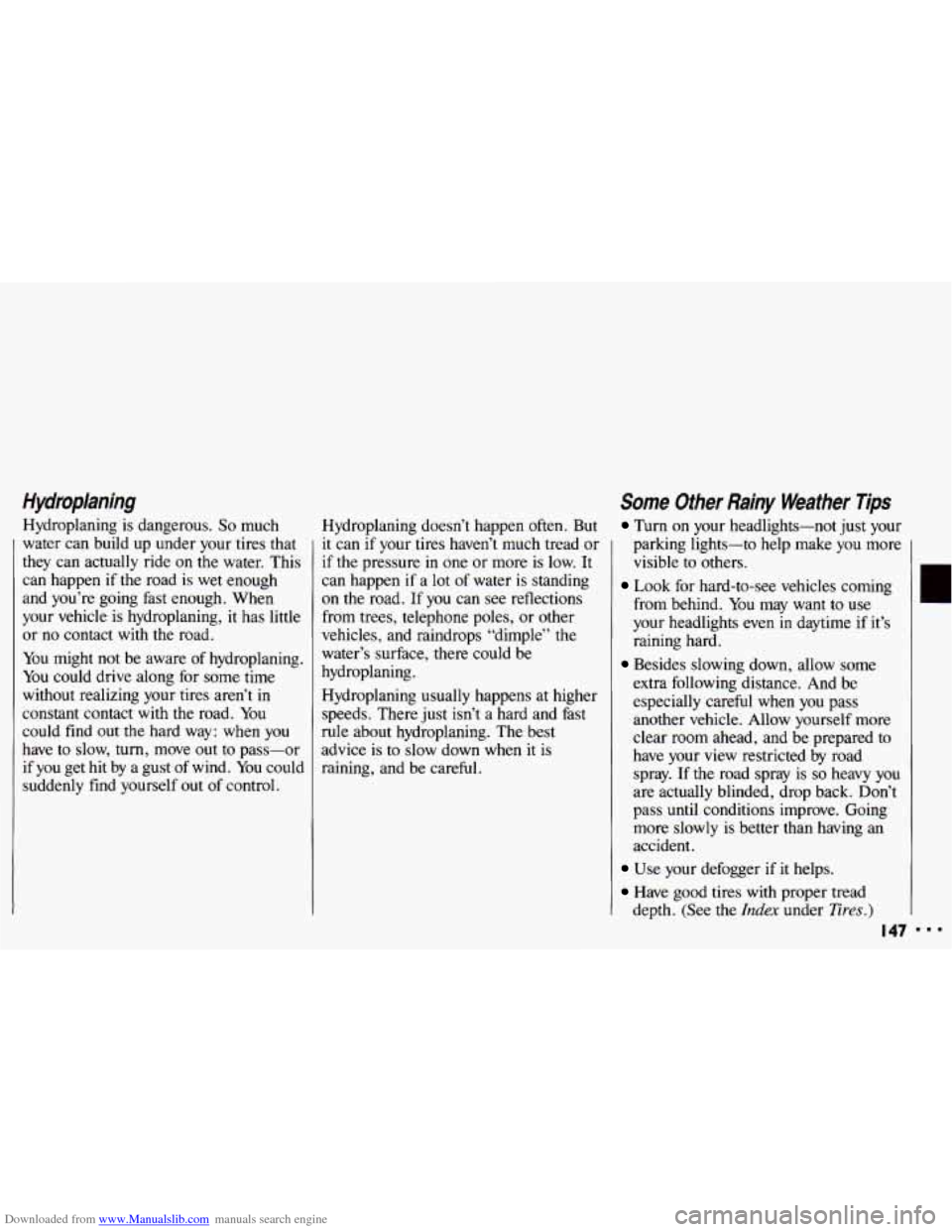
Downloaded from www.Manualslib.com manuals search engine Hydroplaning
Hydroplaning is dangerous. So much
water can build up under your tires that
they can actually ride on the water. This
can happen if the road is wet enough
and you’re going fast enough. When
your vehicle
is hydroplaning, it has little
or
no contact with the road.
You might
not be aware of hydroplaning.
You could drive along for some time
without realizing your tires aren’t
in
constant contact with the road. You
could find out the hard way: when you
have to slow, turn, move out to pass-or
if you get hit by a gust of wind. You could
suddenly find yourself
out of control. Hydroplaning doesn’t happen often. But
it
can
if your tires haven’t much tread or
if the pressure in one or more is low. It
can happen if a lot of water is standing
on the road. If
you can see reflections
from trees, telephone poles, or other
vehicles, and raindrops “dimple’’ the
water’s surface, there could be
hydroplaning.
Hydroplaning usually happens at higher
speeds. There just isn’t
a hard and fast
rule about hydroplaning. The best
advice is to slow down when
it is
raining, and be careful.
Some Other Rainy Weather Tips
Turn on your headlights-not just your
parking lights-to help make you
more
visible to others.
Look for hard-to-see vehicles coming
from behind. You may want
to use
your headlights even
in daytime if it’s
raining hard.
Besides slowing down, allow some
extra following distance. And be
especially careful when you pass
another vehicle. Allow yourself more
clear room ahead, and be prepared to
have your view restricted by road
spray. If
the road spray is so heavy you
are actually blinded, drop back. Don’t
pass until conditions improve. Going
more slowly is better than having an
accident.
Use your defogger if it helps.
Have good tires with proper tread
depth. (See
the Index under fires.)
I47
Page 150 of 308
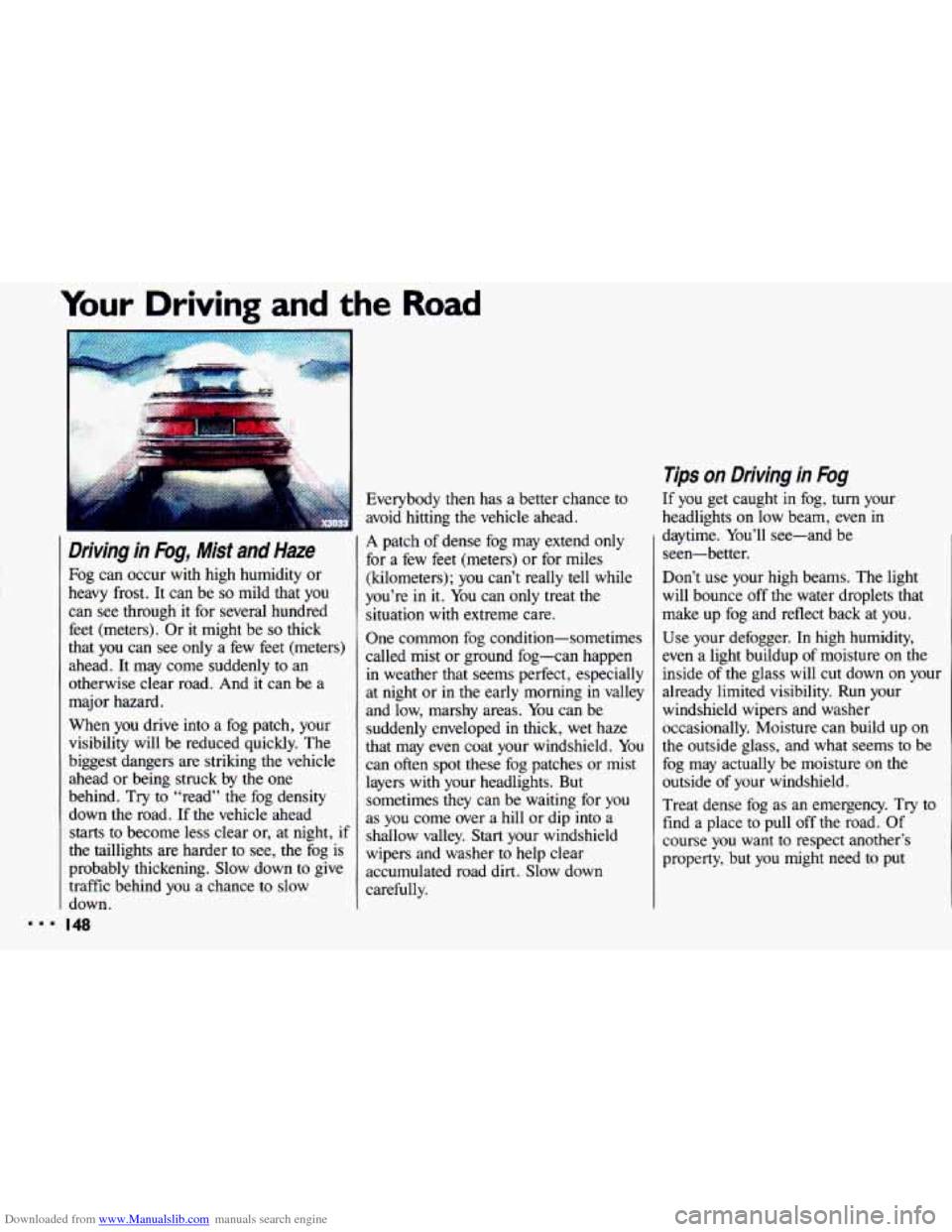
Downloaded from www.Manualslib.com manuals search engine Your Driving and the Road
Driving in Fog, Mist and Haze
Fog can occur with high humidity or
heavy frost. It can be
so mild that you
can see through it for several hundred
feet (meters). Or it might be
so thick
that you can see only a few
feet (meters)
ahead. It may come suddenly to an
otherwise clear road. And it can be a
major hazard.
When
you drive into a fog patch, your
visibility will be reduced quickly. The
biggest dangers are striking the vehicle
ahead or being struck by the one
behind. Try to “read” the fog density
down the road.
If the vehicle ahead
starts to become less clear or, at night, if
the taillights are harder to see, the fog is
probably thickening. Slow down to give traffic behind you a chance to slow
down.
I48
Everybody then has a better chance to
avoid hitting the vehicle ahead.
A patch of dense fog may extend only
for a
few feet (meters) or for miles
(kilometers); you can’t really tell while
you’re
in it. You can only treat the
situation with extreme care.
One common fog condition-sometimes
called mist or ground fog-can happen
in weather that seems perfect, especially
at night or in the early morning
in valley
and low, marshy areas.
You can be
suddenly enveloped
in thick, wet haze
that may even coat your windshield.
You
can often spot these fog patches or mist
layers with your headlights. But
sometimes they can be waiting for
you
as you come over a hill or dip into a
shallow valley. Start your windshield
wipers and washer to help clear
accumulated road dirt. Slow down
carefully.
Tips on Driving in Fog
If you get caught in fog, turn your
headlights on low beam, even in
daytime. You’ll see-and be
seen-better.
Don’t use your high beams. The light
will bounce
off the water droplets that
make up fog and reflect back at you.
Use your defogger. In high humidity,
even a light buildup of moisture
on the
inside
of the glass will cut down on your
already limited visibility. Run your
windshield wipers and washer
occasionally. Moisture can build up
on
the outside glass, and what seems to be
fog may actually be moisture on the
outside of your windshield.
Treat dense fog as an emergency. Try to
find a place
to pull off the road. Of
course you want to respect another’s
property, but you might need to put
Page 162 of 308
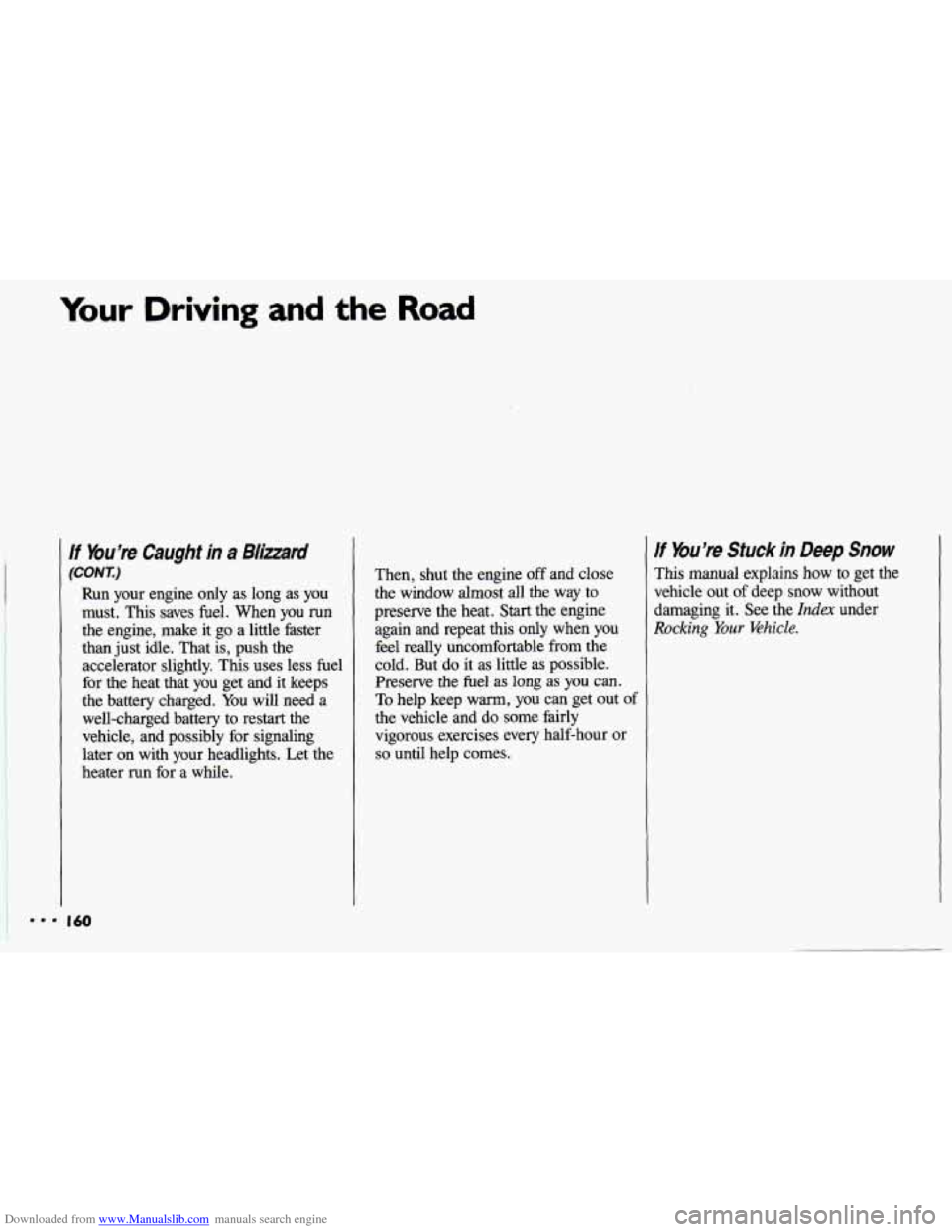
Downloaded from www.Manualslib.com manuals search engine Your Driving and the Road
lf bu're Caught in a Blind
(CONT)
Run your engine only as long as you
must, This saves fuel. When
you run
the engine, make it go a little faster
than just idle. That is, push the
accelerator slightly. This uses less fuel
for the heat that you get and it
keeps
the battery charged. You will need a
well-charged battery to restart the
vehicle, and possibly
for signaling
later on with your headlights. Let the
heater run
for a while. Then,
shut the engine
off and close
the window almost all the way to
preserve the heat.
Start the engine
again and repeat this only when you feel really uncomfortable from the
cold.
But do it as little as possible.
Preserve the fuel
as long as you can.
To help keep
warm, you can get out of
the vehicle and do some fairly
vigorous exercises every half-hour
or
so until help comes.
If You're Stuck in Deep Snow
This manual explains how to get the
vehicle out of deep snow without
damaging it. See the
Index under
Rocking Your Ehicle.
Page 255 of 308
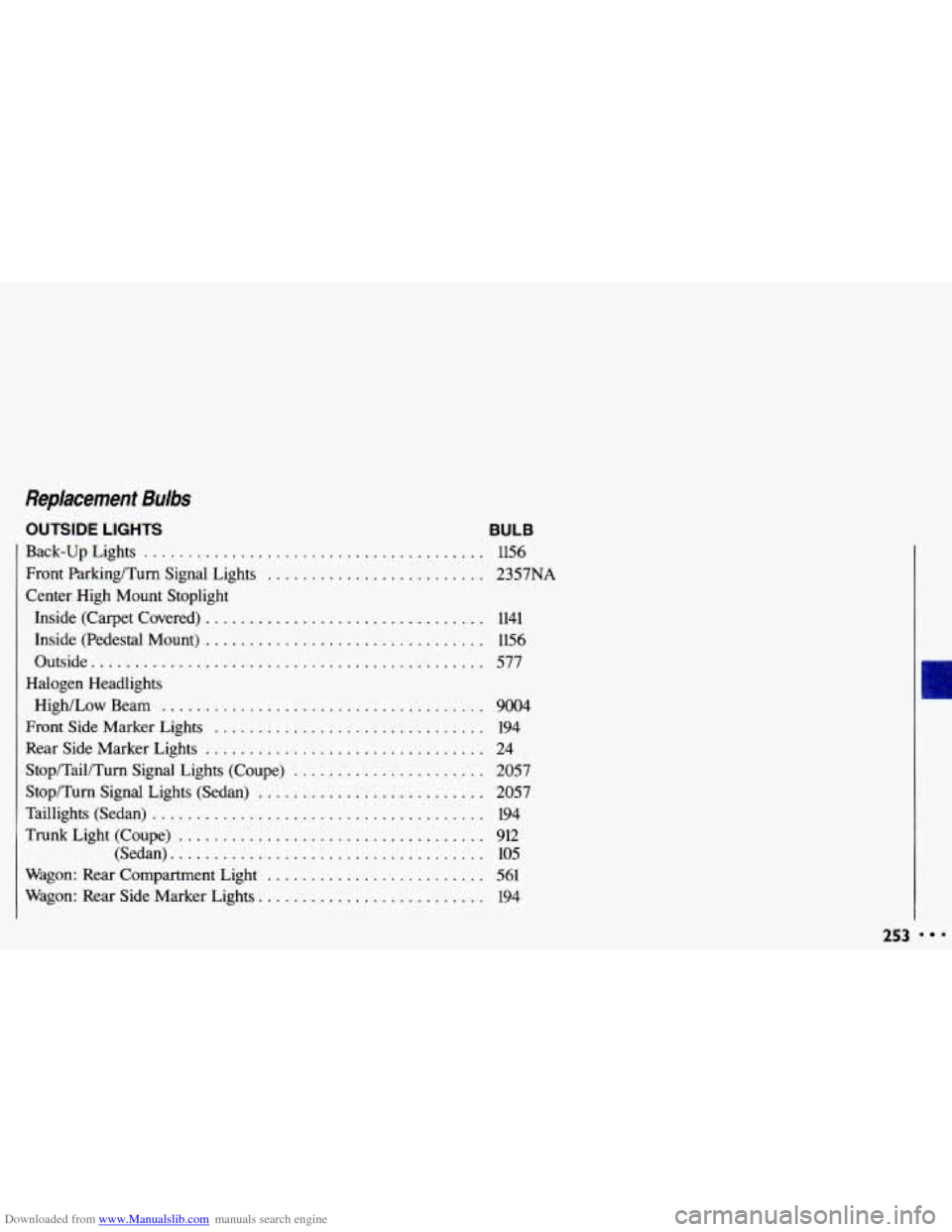
Downloaded from www.Manualslib.com manuals search engine Replacement Bulbs
OUTSIDE LIGHTS
Back-UpLights .......................................
Front Parking/Turn Signal Lights .........................
Center High Mount Stoplight
Inside (Carpet Covered)
................................
Inside (Pedestal Mount) ................................
Outside .............................................
Halogen Headlights
High/LowBeam
.....................................
Front Side Marker Lights ...............................
Rear Side Marker Lights ................................
Stop/Tail/Turn Signal Lights (Coupe) ......................
Stop/Turn Signal Lights (Sedan) ..........................
Taillights (Sedan) ......................................
Trunk Light (Coupe) ...................................
(Sedan) ....................................
Wagon: Rear Compartment Light .........................
Wagon: Rear Side Marker Lights ..........................
BULB
1156
2357NA
1141
1156
577
9004 194
24
2057
2057
194
912
105
561 194
253 a
Page 300 of 308
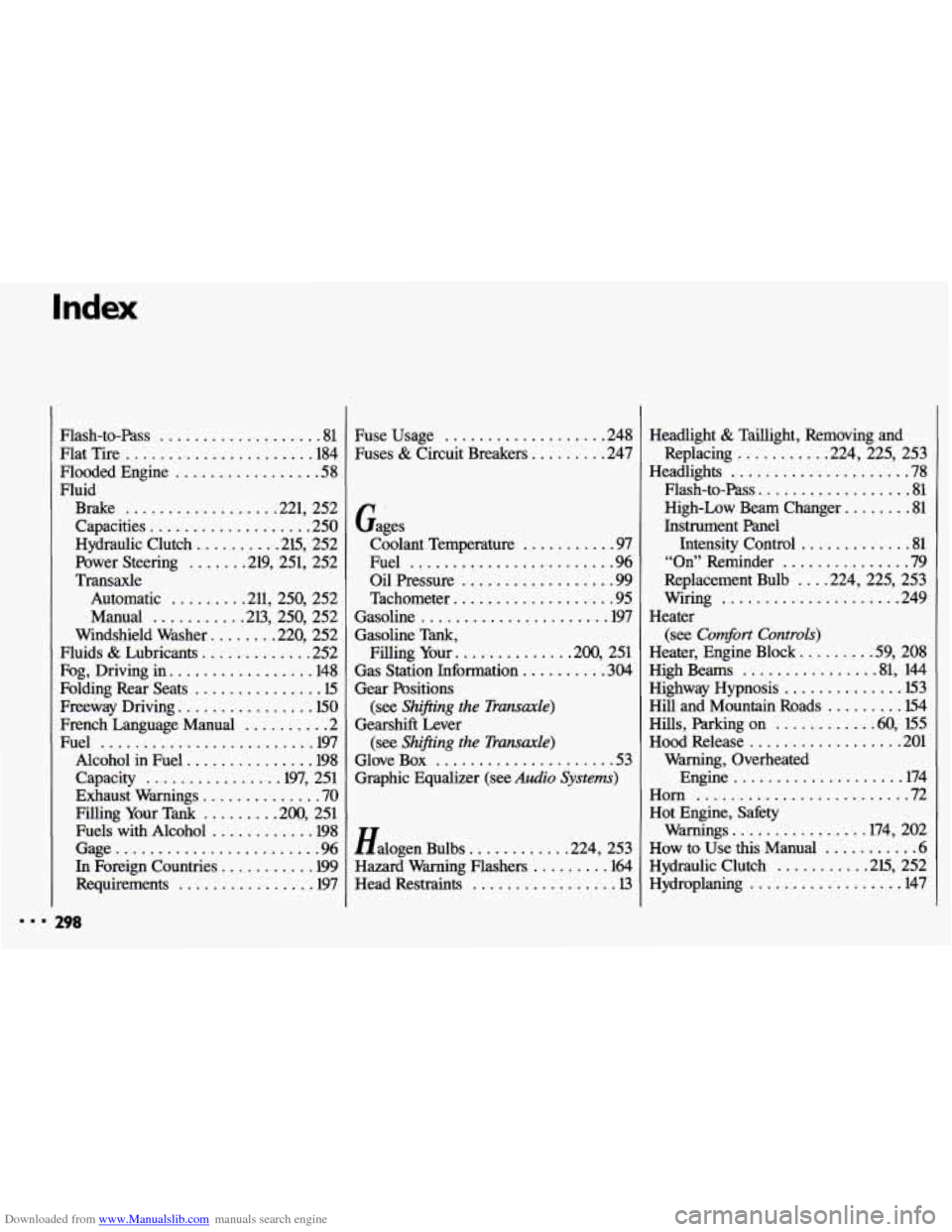
Downloaded from www.Manualslib.com manuals search engine Flash-to-Pass ................... 81
Flat Tire
...................... 184
Flooded Engine
................. 58
Fluid Brake
................. .221. 252
Capacities
................... 250
Hydraulic Clutch
......... .2l5. 252
Power Steering
...... .219. 251. 252
Transaxle
Automatic
........ .211. 250. 252
Manual
.......... .2l3. 250. 252
Windshield Washer
....... .220. 252
Fluids
& Lubricants ............. 252
Fog. Driving in
................. 148
Folding Rear Seats
............... l5
Freeway Driving ................ 150
French Language Manual .......... 2
Fuel
......................... 197
Alcohol in Fuel
............... 198
Capacity
............... .197. 251
Exhaust Warnings
.............. 70
Filling Your Tank
........ .200. 251
Fuels with Alcohol
............ 198
Gage
........................ 96
In Foreign Countries ........... 199
Requirements
................ 197
198
Fuse Usage ................... 248
Fuses
& Circuit Breakers ......... 247
Gaies Coolant Temperature
........... 97
Fuel
........................ 96
Oil Pressure
.................. 99
Tachometer
................... 95
Gasoline
...................... 197
Gasoline Tank. -Filling Your
............. .200. 251
Gas Station Information
.......... 304
Gear Positions
Gearshift Lever
Glove Box
.................... i., . 53
Graphic Equalizer (see
Audio Systems)
(see Shlfing the Transaxle)
(see Shifting the Transaxle)
Halogen Bulbs ........... .224. 253
Hazard Warning Flashers
........ -164
Head Restraints
................. 13
Headlight & Taillight. Removing and
Replacing
.......... .224. 225. 253
Headlights
..................... 78
Flash-to-Pass
.................. 81
High-Low Beam Changer
........ 81
Instrument Panel Intensity Control
............. 81
“On” Reminder
............... 79
Replacement Bulb
... .224. 225. 253
Wiring
..................... 249
(see
Comfort Controls)
Heater Heater. Engine Block
........ .59. 208
High Beams
............... .81. 144
Highway Hypnosis
.............. 153
Hill and Mountain Roads
......... 154
Hills. Parking on
........... .a. 155
Hood Release .................. 201
Engine
.................... 174
Horn
......................... 72
Hot Engine. Safety
Warnings
............... .174. 202
How to Use
this Manual ........... 6
Hydraulic Clutch .......... .2l5. 252
Hydroplaning
.................. 147
Warning. Overheated
Page 301 of 308

Downloaded from www.Manualslib.com manuals search engine Identification Number.
Vehicle
................. .56. 246
Idling Your Engine
........... .68. 71
Sand. Mud. Ice or Snow
........ 192
If You're Stuck: In
Ignition
Key
......................... 48
Key Release Button ............ 55
Positions
..................... 55
Illuminated Entry System
.......... 50
Indicator Lights (see
Warning Lights)
Infant Restraint (see Child Restraints)
Inflation. Tires ................. 230
Inside Rearview Mirror
........... 85
Instrument Panel ................ 93
Instrument Panel Wming'Lights
.... 96
Intermittent Windshield Wipers
..... 83
.................... J ack. Tire 185
Jump Starting
.................. 164
Key Release Button
............. 55
Keys .......................... 48 Lane
Change Indicator
........... 73
Lap-Shoulder Safety Belt
.......... 23
Front
..................... 23. 27
Rear
........................ 28
Use by Children ........... .33. 43
Latches. Seatback
................ 14
Liftgate Ajar Light
................... 102
Lock
........................ 52
Lock Release
................. 52
Safety Warning
................ 52
Lighter
........................ 87
Dome/Map
................... 82
Headlights
................... 78
Lights
Daytime Running Lights
......... 80
Flash-to-Pass .................. 81
Instrument Panel Intensity Control
... 81
Rear Compartment
............ 82
Removing
& Replacing
Bulbs
........... .224, 225, 253
Replacement Bulbs
........... 253
Taillights
.............. .225. 253
Turn Signal
.................. 73
Warning Lights
............... 96
Loading Your Vehicle
....... .91. 227 Locks
......................... 49
Long Distance Driving
.......... 152
Low Oil Pressure Warning
........ 98
Luggage Carrier
................. 91
Low Battery
................... 164
Maintenance Record
........... 279
Maintenance Schedule
.......... 259
Malfunction Indicator Lamp
(Check Engine Light)
.......... 102
Manual Front Seat
............... 12
Manual Sunroof
................. 88
Manual Transaxle
Adding Fluid
....... .215. 250, 252
Shifting
..................... 64
Master Cylinder. Brake
.......... 221
Methanol in Gasoline
........... 198
Mileage Indicator
Mirrors Checking
Fluid
............... 213
Starting the Engine
............ 56
(see
Odometer & Speedometer)
Convex Outside ............... 85
Inside Manual Day/Night ....... 85
299 m ..